How to Buy An Engagement Ring
A 10-Step Guide on how to buy an Engagement Ring with the largest, most-brilliant, eye-clean Diamond at the best price possible.

You Did It.
You Found The One.
She’s brilliant, beautiful and makes you the happiest you’ve ever been. She genuinely cares when your fantasy football team wins. Your family likes her more than they like you.
Let’s Find Her Perfect Diamond
In 20 minutes, we’ll demonstrate how to pick largest, most-brilliant, eye-clean Diamond for your Engagement Ring, at a fraction of average retail price.
Click one or both of the buttons below, to practice searching for a Lab and/or Natural Diamond and let’s begin! Keep that open in a new tab and add the filters with me at every step (I’ll be searching for a Round Natural Diamond, with a $5,000 – $6,000 Budget).
Table of Contents:
- Set A Comfortable Budget Range
- Choose A Reputable Grading Lab
- Pick Your Diamond Shape
- “Excellent” and “Ideal” Cuts Only
- Proportions Are Priority
- Color Grade Just Needs To Look White
- Clarity Grade Just Needs To Be Eye-Clean
- Max Out Carat Weight
- BONUS: The creme-de-la-creme Round Diamonds
- 5 Reasons To Pick Your Center Diamond In Person
Step 1: Set a comfortable Budget Range
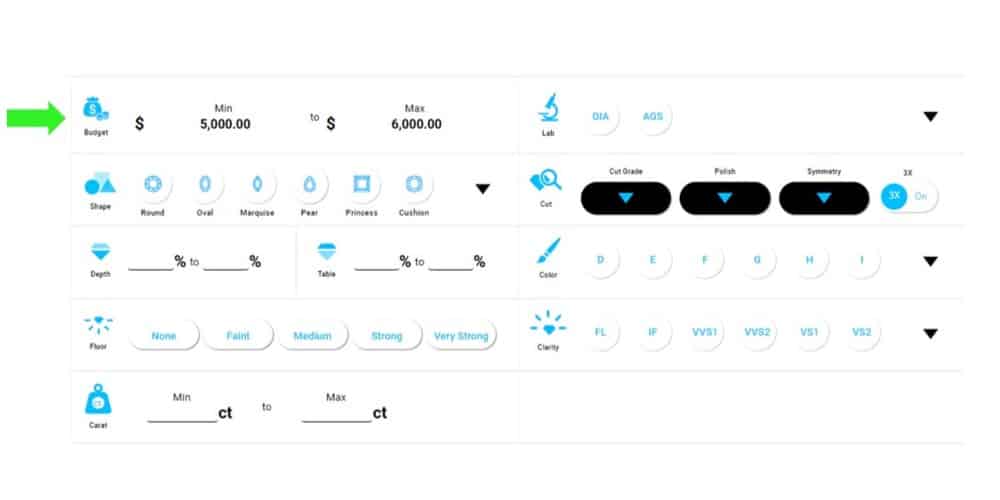
She won’t love it because it’s expensive.
She’ll love it because it’s from you.
There’s no need to go over-budget to find a Diamond she’ll adore. Upon completing this guide, you’ll know how to pick from the absolute best Diamonds that fit your budget.
Want a Natural Diamond’s look for 75-90% less? Opt for a Lab-Grown Diamond.
–
Same physical, chemical and optical properties, and they pass diamonds testers. Learn more about them here.
Step 2: Choose Your Diamond Grading Labs Wisely
What’s a Diamond Grading Lab?
An important part of how to pick an Engagement Ring is picking the right grading lab for your Center Diamond.
A 3rd party grading report from a reputable lab ensures you’re getting what you pay for, meaning that a 1.00 carat “Excellent” Cut, “H” Color, “SI1” Clarity Round Diamond will reflect a generous amount of light, look “white”, and have no clarity imperfections noticeable to the naked eye.
Our two recommended labs for natural diamonds: the GIA® and the AGS®.
For lab-grown diamonds, include the IGI®.
The GIA®
- The Gemological Institute of America is the world’s foremost authority on Diamond grading, research, and education.
- Founded in 1931, the GIA maintains a system of strict evaluative measures in order to protect both buyers and sellers.
- In 1953, they created the 4 Cs (Cut, Color, Clarity, Carat Weight), a convenient method for evaluating and comparing Diamonds to determine their quality and worth.
- The GIA operates in 13 countries with 9 labs and 4 research centers.
The AGS®
- The American Gem Society was founded in 1934 with a focus on protecting consumers from false advertising.
- Their most notable contribution- the introduction of a performance-based Cut Grade system which assigns a Cut Grade to several fancy-shape (non-Round) diamonds.
- Their performance-based system uses ASET Imagery, the same imagery we’ll use together to evaluate your Center Diamond finalists in person. This is an extremely important part of how to buy a Diamond correctly.
The IGI®
- The International Gemological Institute, founded in 1975, is a grading lab we recommend specifically for lab-grown Center Diamonds.
- They have twenty grading laboratories across the world, and in 2005, were the pioneering lab to offer full grading services for lab-grown diamonds.
- Keep in mind, we feel that the GIA and AGS sometimes offer stricter grading in terms of Color.
- For example, a GIA Graded “H” Color Diamond may receive a “G” or “F” Color Grade from the IGI.
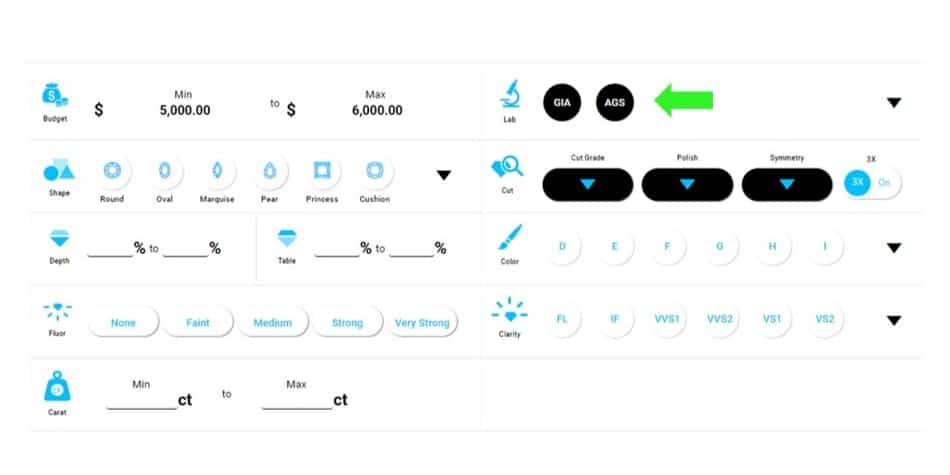
How To Buy An Engagement Ring, Step 3:
Pick Your Diamond Shape
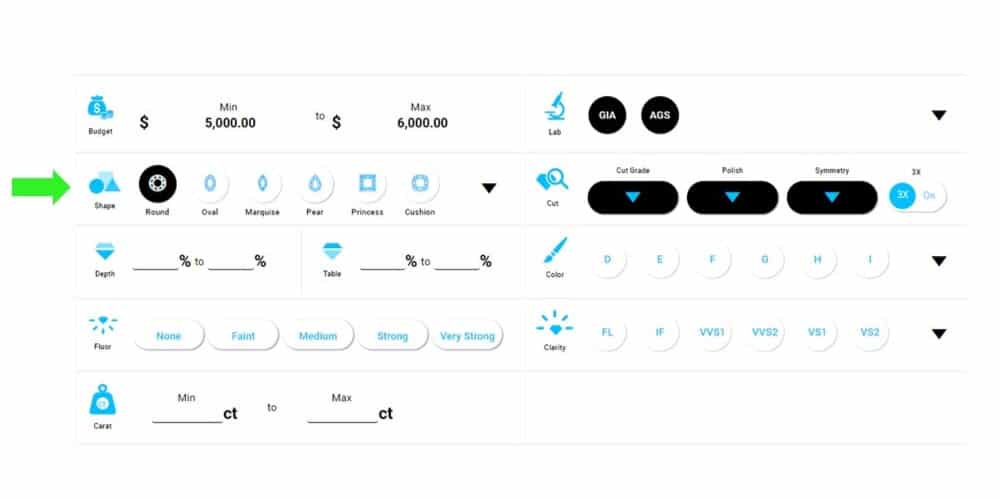
With budget in place, it’s time to pick your Diamond’s shape.
Below are the 10 most popular Center Diamond shapes. Let’s meet the contestants…
The Round Brilliant-Cut Diamond
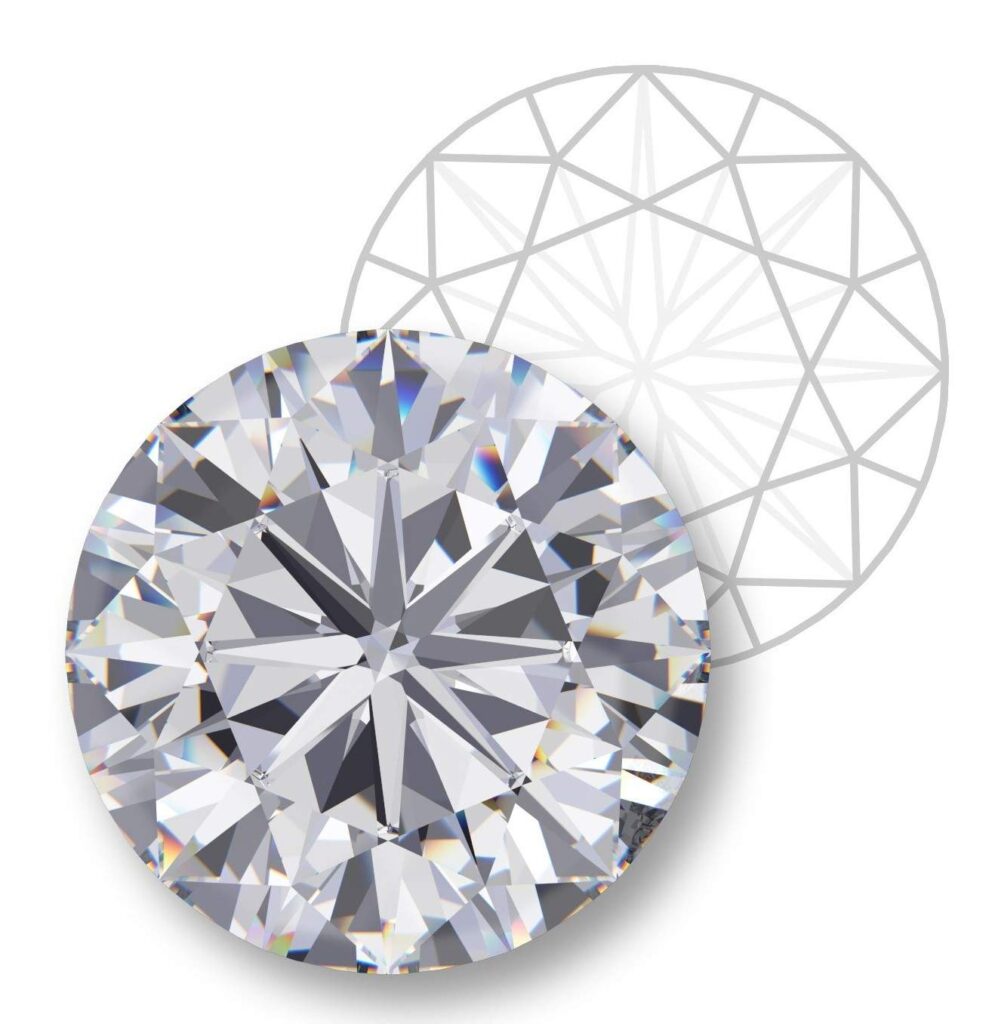
Round Brilliant-Cut Diamond
Over centuries of improvements in diamond cutting, we arrived at the Round-Brilliant in 1919. It’s the most popular shape of Diamond, and it’s never going out of style.
What’s a “Brilliant-Cut” Diamond?
A diamond shape that’s cut with a precise arrangement of facets to maximize sparkle and light performance.
Of the 10 most popular Center Diamond shapes, 8 are brilliant-cut:
Round, Oval, Marquise, Pear, Princess, Cushion, Radiant and Heart.
What we love about Rounds:
1. Better light reflection and sparkle than any other shape.
2. The most popular Center Diamond shape in the world, Rounds look great on any style Engagement Ring.
What to be careful with:
The only point of caution here is price, as Round-Brilliants tend to be the most expensive shape.
BUT, with optimized Cut, Color and Clarity, cash won’t be a problem.
The Tall Brilliants
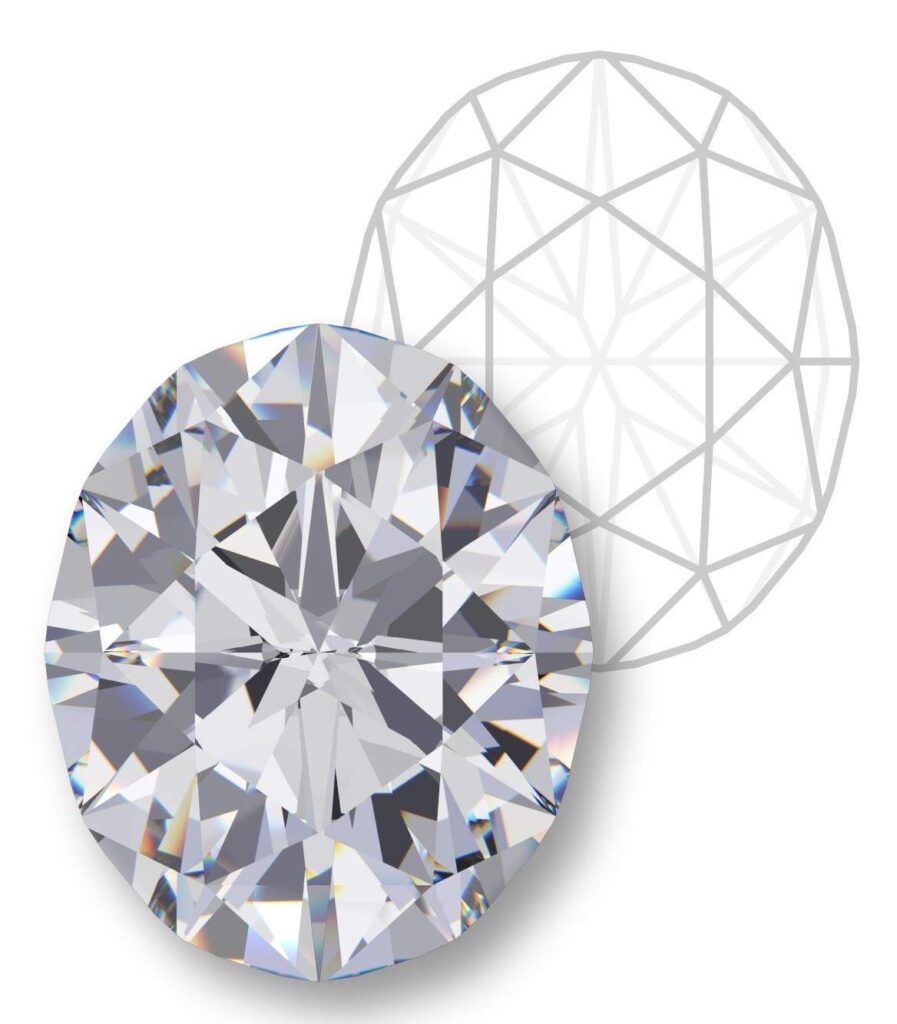
Oval Diamonds
Best L/W Ratio: 1.30 – 1.40
Ovals are an elongated version of the Round-Brilliant, created in the 1960s. Their impressive height and excellent sparkle make them an excellent choice for your Center Diamond, one of the most popular diamond shapes in recent years.
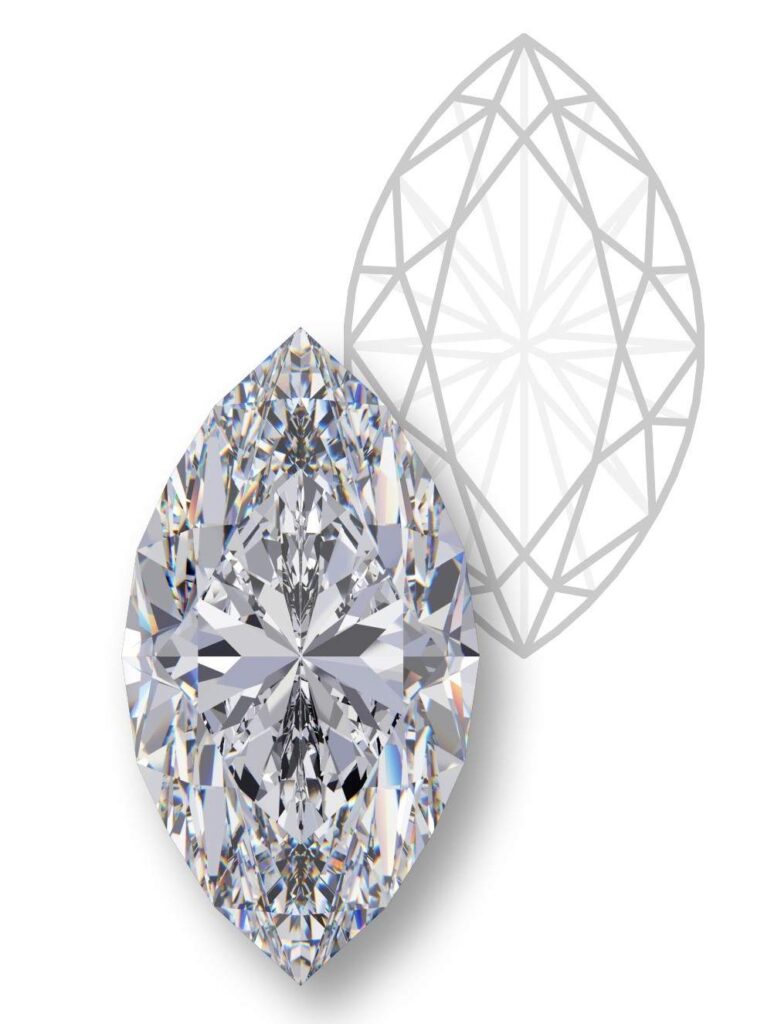
Marquise Diamonds
Best L/W Ratio: 1.60 – 2.20
The Marquise Diamond was commissioned by Louis XV in the 18th century- as a gift to his mistress- and found its way onto the ring fingers of wives across the world. Setting the origin story aside, the Marquise is a unique and elegant choice for your Ring’s Center Diamond.
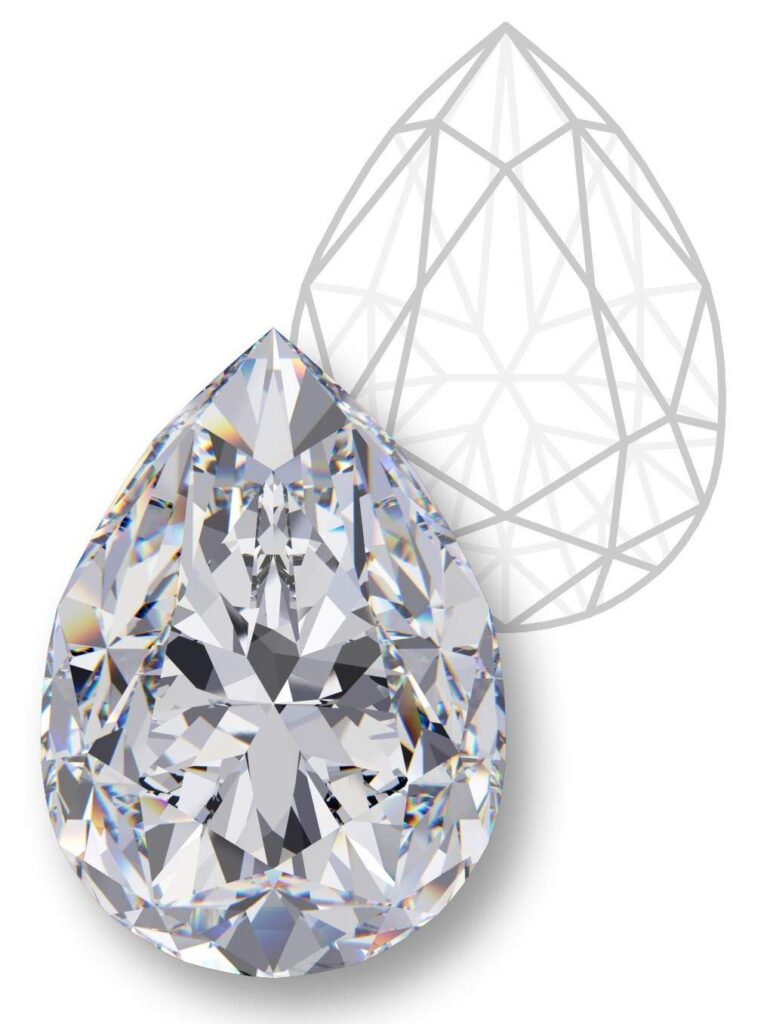
Pear Diamonds
Best L/W Ratio: 1.45 – 1.75
What do you get when a Round-Brilliant and a Marquise walk into a bar?
- The perfect bar to burglarize
- A Pear-Shape Diamond
A 1400s cross between a Round and a Marquise, Pears form a beautiful teardrop shape with a faceted point.
What we love about them:
1. Big height = larger look at the same carat weight than a Round-Brilliant or square-shape.
2. Very good light performance.
3. (Usually) cheaper than an equivalent Round-Brilliant.
4. Pick your favorite Length to Width (L/W) Ratio. Larger L/W = taller stone, Smaller L/W = wider & more rounded.
What to be careful with:
1. Protect the points on a Marquise or Pear with a bezel or v-prong setting!
2. Some degree of “bowtie effect” is present on each of these.
See your Diamond in person to be safe! We’ll help you pick one with an indistinguishable bowtie at the best price possible.
The Square Brilliants

Princess-Cut Diamonds
Princess-Cut Diamonds were developed in the 1980s, with sharp edges that form a sleek, elegant look.
They offer the 2nd best light performance of all shapes, behind only Round-Brilliants.
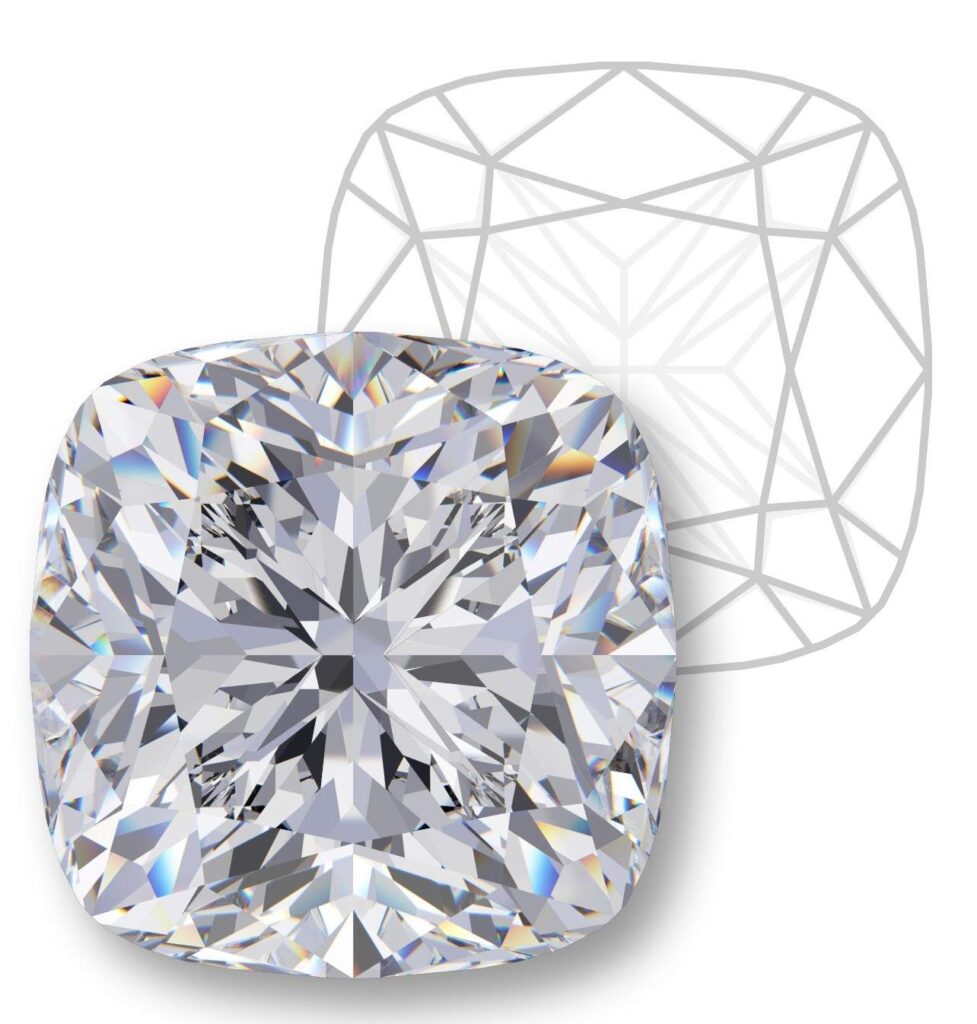
Cushion Diamonds
Cushion Diamonds are Brilliant-Cut square shapes with rounded corners. Cushions were originally created in the 1800s with larger, broader facets, but have since been updated to a Brilliant-Cut shape bursting with light.
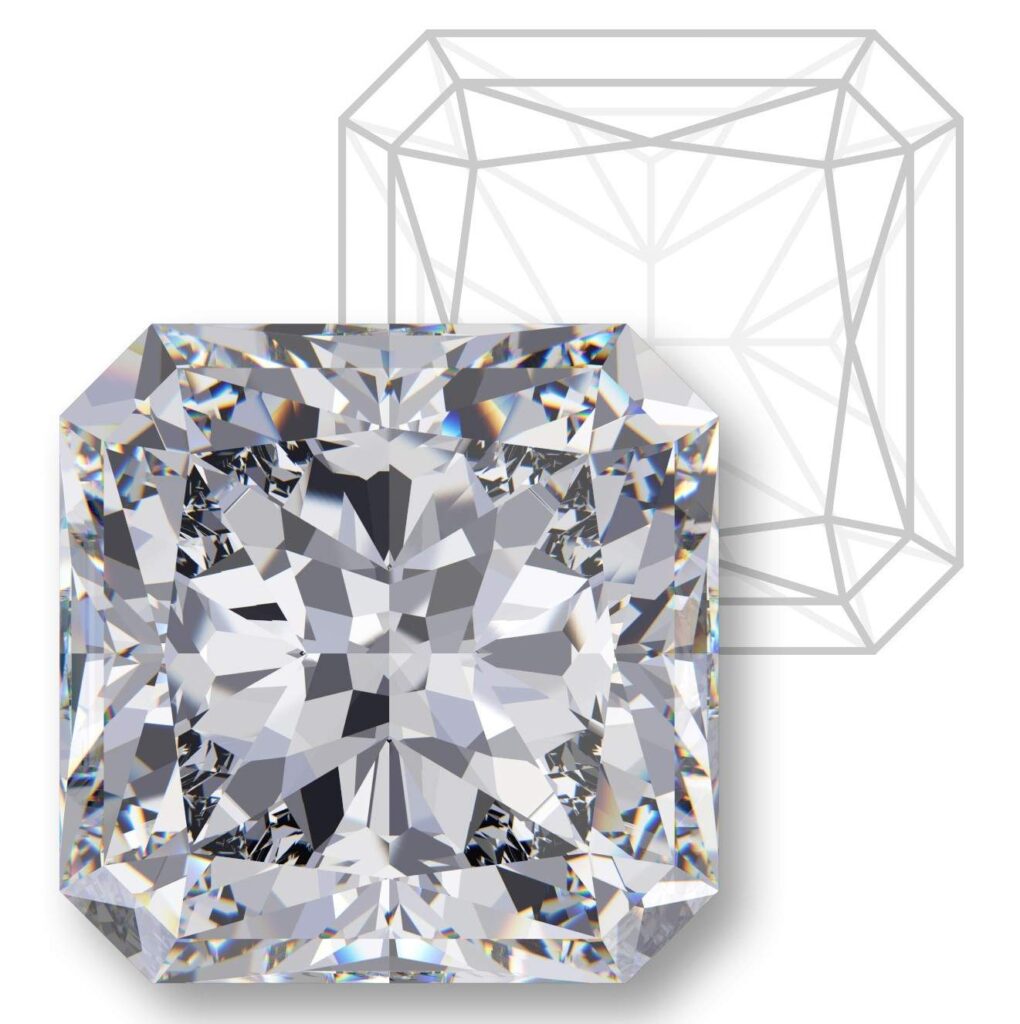
Radiant Diamonds
A combination of the Round-Brilliant and Emerald shapes created in the 1970s, Radiants are a unique and beautiful choice for your Ring’s Center Diamond.
What we love about them:
1. Very good light performance.
2. (Usually) cheaper than an equivalent Round-Brilliant.
What to be careful with:
1. Protect the points on a Princess-Cut with a bezel or v-prong setting!
2. Square shapes appear smaller at equivalent carat weights than Round-Brilliants and elongated shapes.
A 1.50 carat square-shape has roughly the same surface area as a 1.00 carat Round, but the square is less expensive. Pick the shape that looks best and biggest within a comfortable budget.
The Step-Cuts
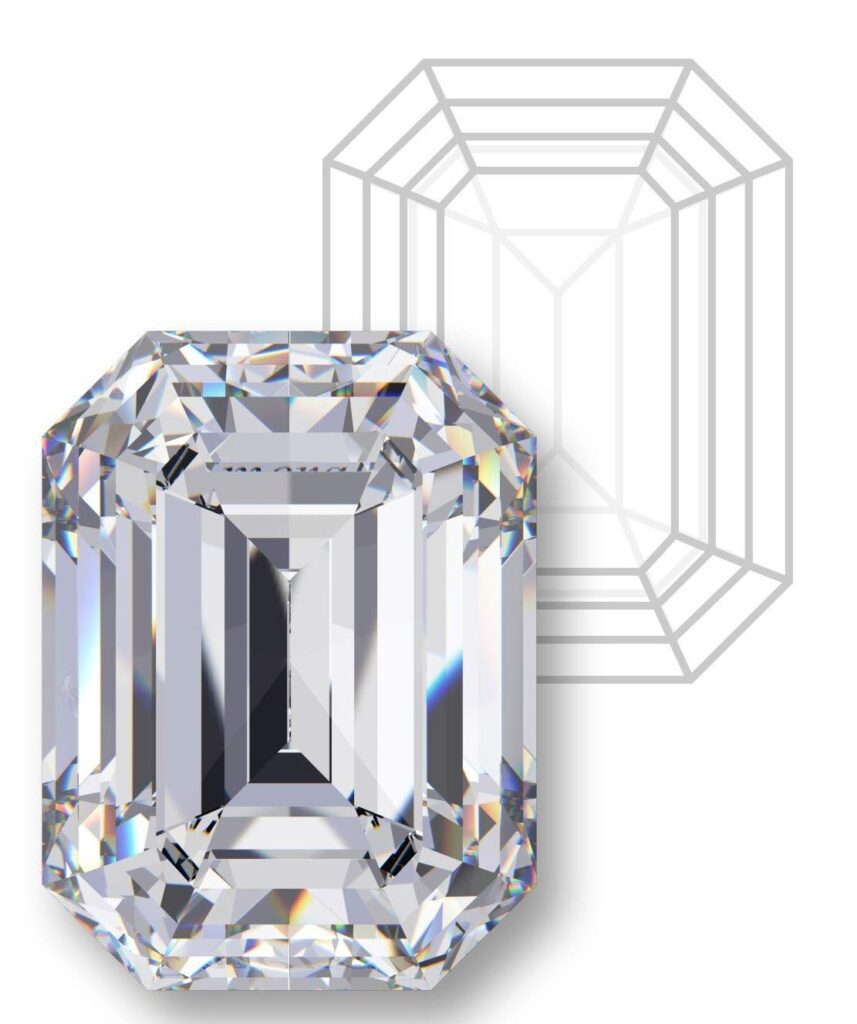
Emerald-Cut Diamonds
Emerald-Cuts make an extremely elegant option for your Ring’s Center Diamond. This shape dates back to the 1500s, and was originally used to cut the gemstone Emerald. No bonus points for creative naming, but a beautiful shape nonetheless.
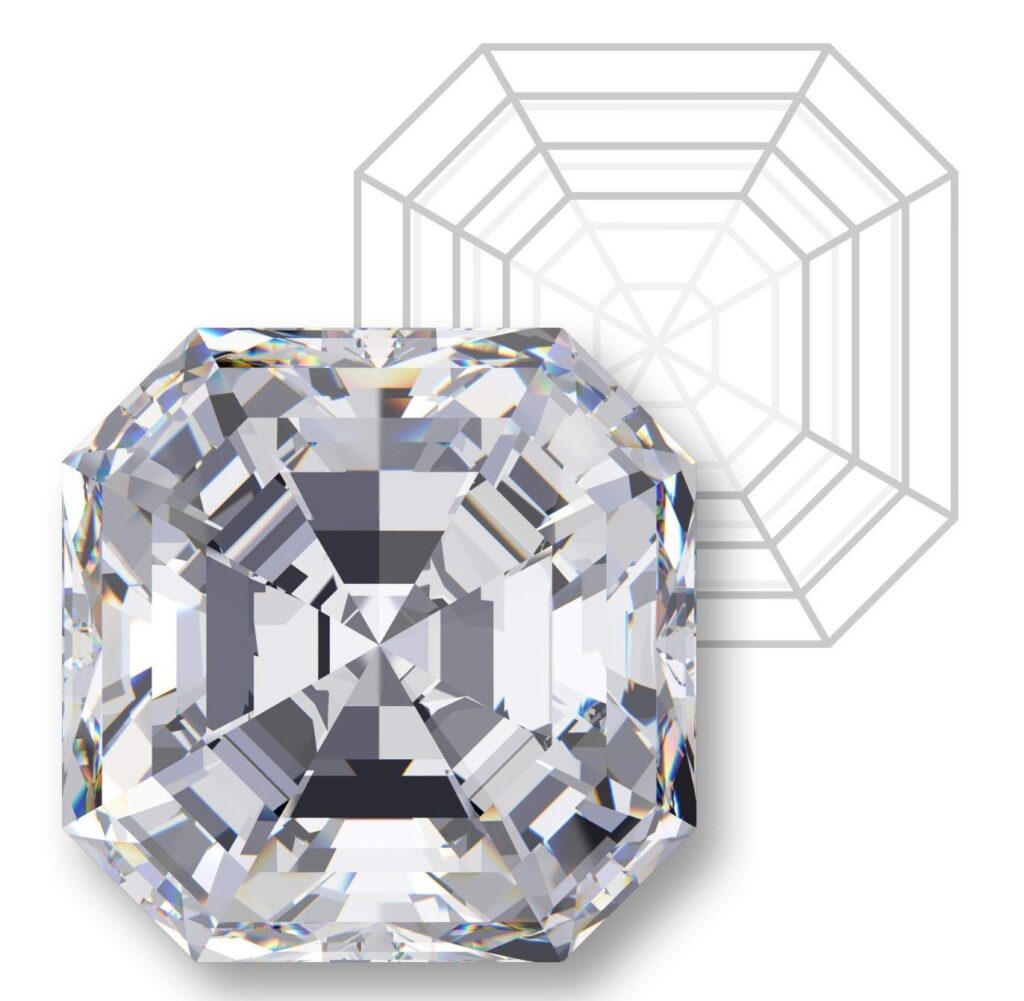
Asscher Diamonds
Created by Joseph Asscher in 1902, Asschers are a square version of the Emerald-Cut, and share practically the same characteristics but in a beautiful, cubic shape.
What’s a “Step-Cut” Diamond?
A shape with with parallel, elongated facets. They’re clean and sharp, but sacrifice sparkle.
Emerald-Cuts and Asschers Diamonds are the two step-cut Center Diamond shapes.
What we love about them:
1. The most affordable shapes available.
2. Unique and elegant facet pattern.
3. Perfect for Art Deco and vintage-style Engagement Rings.
4. Emerald-Cuts appear larger than non-elongated shapes of equivalent carat weight, due to their impressive height.
What to be careful with:
1. Step-cuts have poor brilliance compared to brilliant-cut shapes.
2. Asschers (like all square shapes) appear smaller at equivalent carat weights than Round-Brilliants and elongated shapes.
The Heart-Shape

Heart-Shape Diamonds
Heart Diamonds are a unique symbol of forever love. Mary Queen of Scots sent Queen Elizabeth a Heart Diamond in 1562, which cemented this shape’s place in history.
What we love about them:
1. You won’t see many Heart-Shapes on Engagement Rings, making these a rare and beautiful Center Diamond option.
2. As they are quite literally a heart made of of diamond, the Ring possibilities are endless.
What to be careful with:
1. When selecting a Heart Diamond, the symmetry of both halves needs to be extremely precise. The cut between both lobes needs to be defined and the stone itself typically needs to be at least 1 carat for its signature shape to be noticeable.
2. Hearts are the second most expensive shape, behind the Round-Brilliant.
Step 4: Cut Grade needs to be the very best
What is Cut Grade?
Cut Grade measures how well a Diamond reflects light.
It is the most important of the 4 Cs!
Our Objective:
Choose a Diamond with the best Cut Grade possible.
This is the 1st step in ensuring that your Diamond:
- Looks the size it’s intended to (not smaller)
- Masks tints of coloration
- Hides clarity imperfections
- Sparkles and returns maximum light
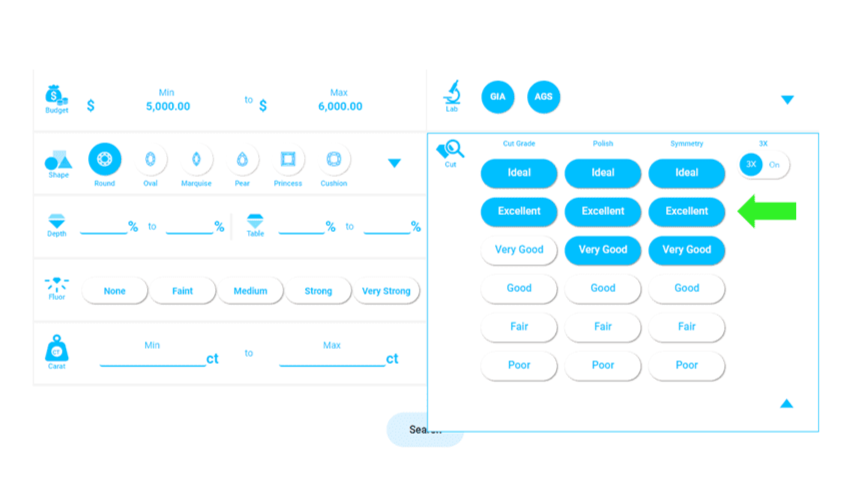
IMPORTANT NOTE: While GIA® Graded Fancy-Shapes and most AGS® Graded Fancies don’t receive a Cut Grade, we’ll review their light performance in person using an ASET Scope! This is an objective and easily-digestible way of evaluating how well a Diamond interacts with light.
Step 4a: Polish & Symmetry, Cut’s partners in shine
What are they?
Polish refers to the quality and shine of a Diamond’s facets.
Symmetry refers to the evenness of a Diamond’s facets, leading to an even display of brightness, fire, and scintillation.
Our Objective:
Eliminate any Diamonds with uneven or roughly-polished facets.
While these are both important factors for a brilliant Center Diamond, they’re not as important as Cut Grade. A “Very Good” note on Polish and/or Symmetry doesn’t disqualify a Diamond from our search.

How To Buy An Engagement Ring, Step 5:
Proportions are Priority
What do Proportions tell us?
To continue eliminating subpar-performing Diamonds, we use Proportions. Proportions are the geometrical makeup of a Diamond, which tell us how well it reflects light, how well its weight is distributed, and how precisely it is cut.

• Table Percentage: The table (flat, top facet) accepts light and reflects it from the pavilion (bottom half of a Diamond) back at the observer. Too large of a table harms fire (rainbow-colored light) and too small of a table means poor light performance.
• Depth Percentage: A shallow depth means more light will pass through the stone instead of being reflected back at the viewer. But, if a stone is too deep, its weight distribution will be incorrect and it will look smaller table-up than a correctly-cut Diamond of equal carat weight.
| Diamond Shape | “Excellent” Depth % | “Excellent” Table % |
|---|---|---|
| Round | 59 – 63% | 54 – 58% |
| Oval | 58 – 63% | 56 – 62% |
| Marquise | 57.5 – 64.5% | 56 – 64% |
| Pear | 57.5 – 65% | 55.5 – 63% |
| Princess | 65 – 73% | 65 – 74% |
| Cushion | 62 – 68% | 55 – 62% |
| Radiant | 62 – 68% | 62 – 67% |
| Emerald | 60 – 68% | 58 – 68% |
| Asscher | 63 – 69% | 58 – 64% |
| Heart | 51.9 – 61% | 58 – 64% |

Step 6: Color Grade just needs to look white
What is Color Grade?
Picking the right Color Grade is a very important part of how to buy a Diamond with your budget optimized. It measures the degree of yellow or brown tints of coloration in a Diamond. The earlier in the alphabet, the higher the Color Grade. The higher the Color Grade, the whiter the Diamond.
Our Objective:
Pick the lowest Color Grade that appears white to the eye.
Two things to keep in mind:
- Everyone’s color sensitivity (the color grade at which you notice tints of brown or yellow and no longer see a “white” diamond) is different.
- Coloration is most visible in larger and less-brilliant stones, so we’ll finalize Color Grade corresponding to your Diamond’s Carat Weight and facet pattern (Brilliant-Cut or Step-Cut) in Step 9.
Nearly all GIA or AGS graded diamonds 2.00 carats and under will look “white” in this range. We’ll make adjustments if needed at step 9.
In our experience, the IGI does not grade Color as strictly as the GIA or AGS. Add two Color Grades up if you’re searching for an IGI Graded Lab-Grown Diamond.

Step 6a: Fluorescence 101
What is Fluorescence (FL)?
The intensity of visible light emitted by certain diamonds in the presence of ultraviolet (UV) rays. FL has to be a “Medium” or greater to impact a stone’s appearance, and that impact is most visible under concentrated UV light.
Does FL have a positive or negative effect on your Center Diamond?
According to a 1997 GIA® study, “strongly fluorescent diamonds had a better color appearance table-up”, an effect most visible at lower color grades (“I” or lower).
The study challenged the notion that strongly fluorescent diamonds appear hazy, and concluded by stating that “the diamond industry would be better served by considering each individual diamond on its own merits”. We couldn’t agree more. (Moses, Reinitz, Johnson, King, Shigley 1997).
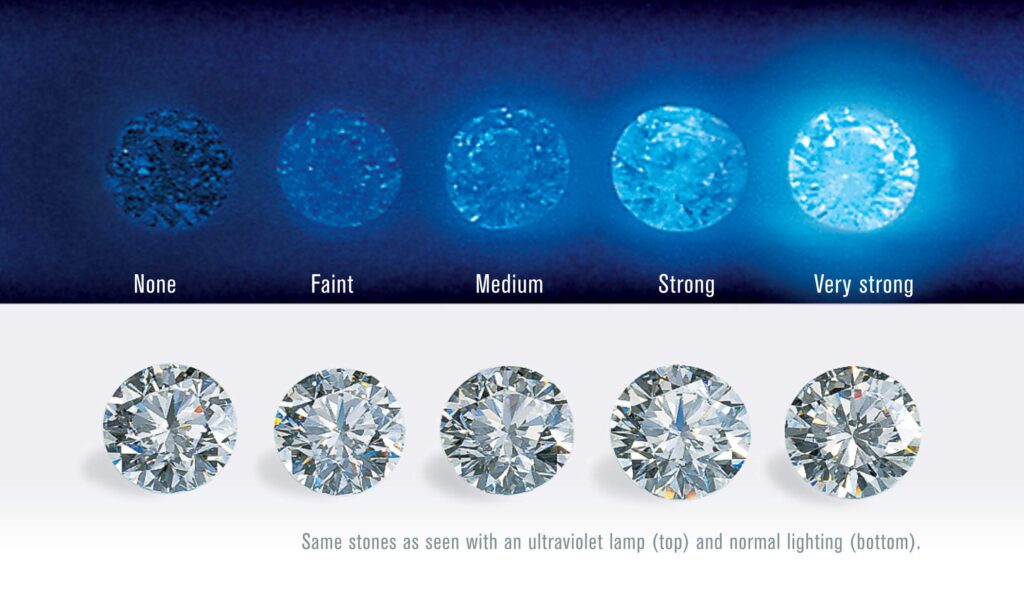
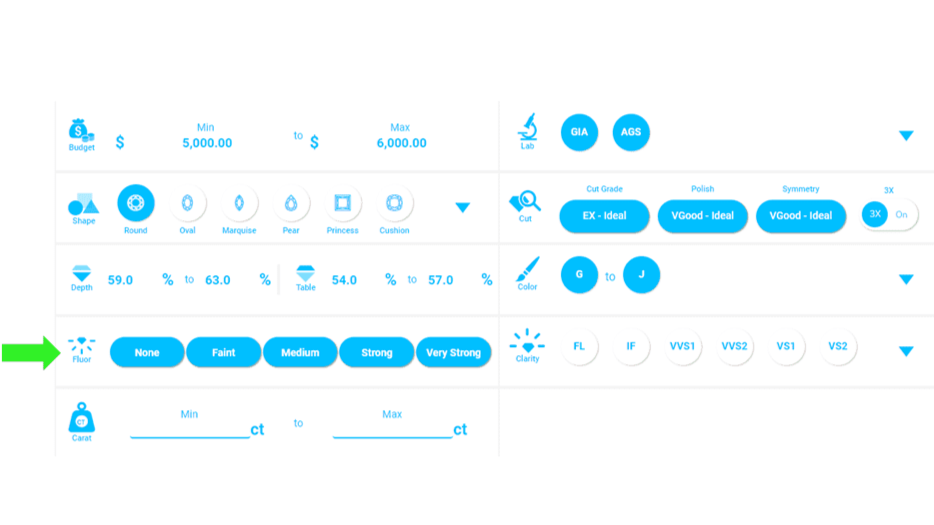
How To Buy An Engagement Ring, Step 7:
Clarity Grade just needs to be eye-clean
What is Clarity Grade?
Clarity is a measure of the number and degree of clarity imperfections a diamond contains, both interior (“inclusions”) and on its surface (“blemishes”).
Our Objective:
Pick the lowest Clarity that’s “eye clean”.
Eye clean = no imperfections visible to the naked eye. Straying too far above the lowest eye clean Clarity Grade means paying for a feature only visible under a microscope!
Just like with Color Grade:
- “Eye cleanliness” is subjective and differs from person to person.
- Imperfections are most noticeable in larger and less-brilliant Diamonds, so we’ll also finalize Clarity Grade corresponding to your Diamond’s Carat Weight and facet pattern (Brilliant-Cut or Step-Cut) in Step 9.
Nearly all GIA or AGS graded diamonds 2.00 carats and under will look “eye clean” in this range. We’ll make adjustments if needed at Step 9.

Step 8: Max out Carat Weight
What is Carat Weight?
Carats are simply a measure of how much a Diamond weighs.
Our Objective:
Get the biggest Rock that fits your budget.
2 things to keep in mind:
- Noticeable differences in diamond size occur roughly every 0.50 carats. For example, a 1.00 carat will look noticeably smaller than a 1.50 carat, which will look noticeably smaller than a 2.00 carat.
- Therefore, prices tend to increase significantly at multiples of 0.50 carats.
- Keep an eye out for stones in between multiples of 0.50 carats. For example, a 1.32 carat. This diamond won’t look much smaller than a 1.50 carat, but might be priced at a nice discount.
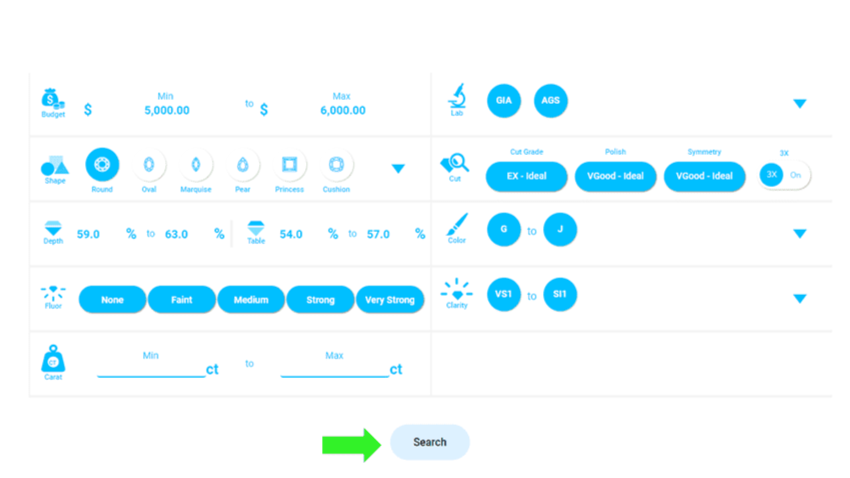
My search left me with 50 eligible Diamonds.
Let’s narrow that down to the biggest and brightest.
Step 8a: Sort Carat Weight by Largest to Smallest


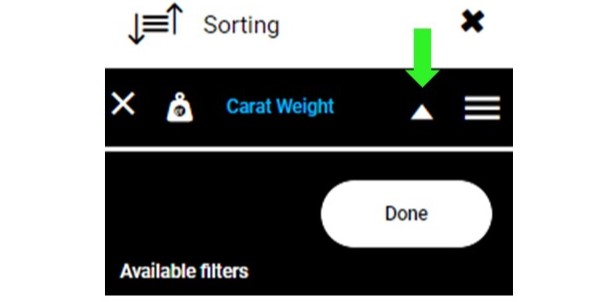
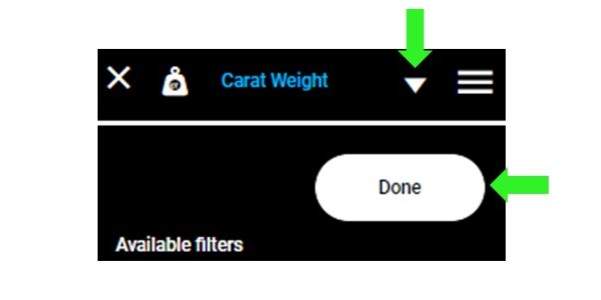

Step 8b: Double-check Color Grade
Based on Carat Weight and Facet Pattern, the lowest “white” GIA or AGS Color Grade for your Center Diamond will likely be:

- Under 2.00 carats: “I” or “J”
- 2.00 – 3.00 carats: “H” or “I”
- Over 3.00 carats: “G” or “H”
Why?
• Round-Brilliants return light better than any other shape. Better light performance means more brilliance (returned white light). More brilliance means better masking of color tints.
• A well-cut (“Excellent” or “Ideal” Cut Grade with top Proportions) Round Diamond reflects so much light, coloration gets lost in the sparkle.
Cushion, Heart, Marquise, Pear, Princess, Oval, Radiant

- Under 1.50 carats: “H” or “I”
- 1.50 – 2.00 carats: “G” or “H”
- 2.00 – 2.50 carats: “F” or “G”
- 2.50 – 3.00 carats: “E” or “F”
- Over 3.00 carats: “D” or “E”
Why?
• Remember, Fancy Brilliants return light well, but not as well as Rounds. Going a grade or two higher than an equally-sized Round should guarantee a “white” stone.
Emerald-Cut and Asscher

- Under 1.25 carats: “H” to “I”
- 1.25 – 1.75 carats: “G” to “H”
- 1.75 – 2.25 carats: “F” to “G”
- 2.25 – 2.75 carats: “E” to “F”
- Over 2.75 carats: “D” to “E”
Why?
• Of these 3 categories, Step-Cuts return the least light and mask coloration the most poorly, so they’ll need to be a higher Color Grade to look white.
• However, Step-Cuts are less expensive than equivalent Brilliant-Cuts, so that upgrade in Color shouldn’t put you out your budget.
DON’T FORGET!
Add 1-2 Color Grades up to the grades above if searching for an IGI Graded lab-grown Center Diamond. For example, a Round under 2.00 carats will most likely look “white” at grades “G” or “H”.
Step 8c: Double-check Clarity Grade
Based on Carat Weight and Facet Pattern, the lowest “eye clean” Clarity Grade for your Center Diamond will likely be:

- Under 1.00 carat: “SI1” or “SI2”
- 1.00 – 2.50 carats: “VS2” or “SI1”
- 2.50 – 3.00 carats: “VS1” or “VS2”
- Over 3.00 carats: Start with “VS1”, as you approach 4.00 carats, move into “VVS2”
Why?
A Round or Fancy Brilliant-Cut’s faceting pattern does an excellent job of hiding clarity imperfections. It’s very difficult to pick out imperfections with all that light reflecting back at you.

- 1.25 carat and under: “VS2” or “SI1”
- 1.25 – 2.50 carats: “VS1” or “VS2”
- 2.50 – 3.00 carats: “VVS2” or “VS1”
- Over 3.00 carats: “VVS1” or “VVS2”
Why?
A Step-Cut’s elongated facets do a poor job of hiding imperfections, so its Clarity Grade needs to be higher than an equivalent size Brilliant-Cut’s.
Now let’s pick out some semi-finalists…
I’ll pick out 3 stones to analyze here, which are by no means the only great Diamond options from the 16 above. Now that you know what Color and Clarity your Diamond should be, you can analyze them on your own search and pick from the best.
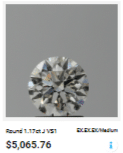
The 1.17 carat J/VS1
- We know that Center Diamonds under 2.00 carats are going to look “white” at Color Grades “I” or “J” (or better).
- This one costs less than all the other “J” Diamonds near its size, in part due to “Medium” Fluorescence. But, we already learned that Fluorescence is almost always a good thing, especially on stones graded “I” or lower color.
- “VS1” is guaranteed eye clean for this carat size.
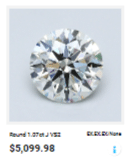
The 1.07 carat J/VS2
- “J” Color = it’ll look white.
- “VS2” Clarity = eye clean.
- What really caught my eye on this one is the evenness of the arrows. In the next (and final) step, we’ll explain the numbers behind what our eyes are seeing.
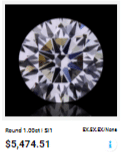
The 1.01 carat I/SI1
- Now I want to compare a Diamond with slightly higher Color Grade that’s eye clean and still within budget.
- I also love how even the arrows look on this one. Tremendous contrast between light and dark areas, you can tell this one sparkles light a disco ball.
Step 9: Picking The Very Best “Excellent” Cut Diamonds
Round Brilliant-Cuts are the most popular shape by far, accounting for roughly 80% of all Engagement Rings’ Center Diamonds. After 9 steps of filtering, if you’re stuck between a few different Rounds, here’s how to pick out the absolute best.

| Table % | Depth % | Crown Angle | Pavilion Angle | Lower Girdle Length | Star Facet Length |
|---|---|---|---|---|---|
| 54 – 58% | 59 – 63% | 34.0 – 35.5° | 40.6 – 41.0° | 75 – 80% | 45 – 55% |
The more of these figures within the ranges of above, the brighter the Diamond will shine.
Where are they on a GIA® Report?
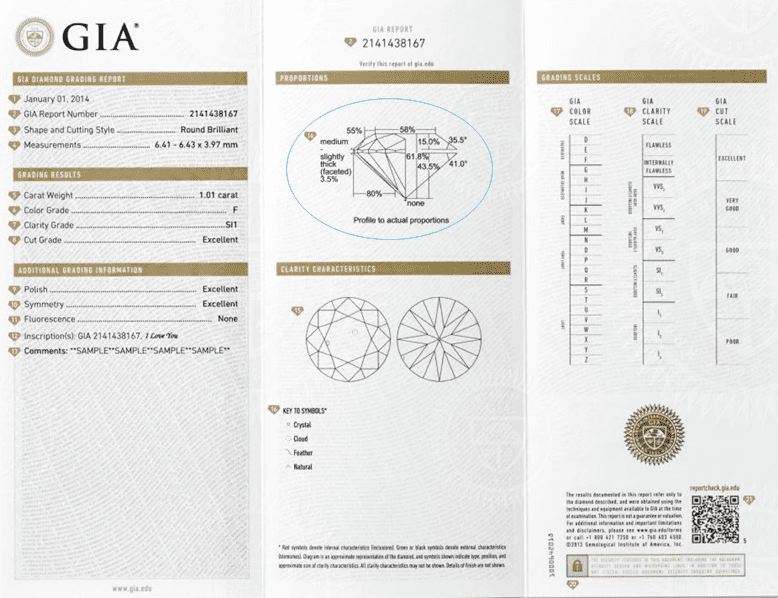
- Crown Angle: The crown regulates the degree of a fire (rainbow-colored light) a Diamond emits.
- Pavilion Angle: The pavilion is extremely important- it reflects light back through the table at the observer.
- Lower Girdle Facet Length: determines appearance of “arrows” from a table-up view.
- Star Facet Length: Overly long stars lead to less light return and overly short stars lead to less contrast brilliance.
How did our semi-finalists do?
1.17 carat J/VS1

- Crown Angle: 36.5°
- Pavilion Angle: 41.0° ✅
- Lower Girdle Facet (LGF) Length: 80% ✅
- Star Facet Length: 50% ✅
1.07 carat J/VS2

- Crown Angle: 35.5° ✅
- Pavilion Angle: 40.8° ✅
- LGF Length: 75% ✅
- Star Facet Length: 50% ✅
1.00 carat I/SI1

- Crown Angle: 34.5° ✅
- Pavilion Angle: 40.8° ✅
- LGF Length: 80% ✅
- Star Facet Length: 50% ✅
Why? Of the two “J” Colors, the 1.07 carat J/VS2 for $5,100 is my favorite option. Its Crown Angle is within ideal range, and a 0.10 carat difference is barely (if at all) noticeable. The 1.00 carat I/SI1 for $5,475 is well within budget, awesome Color for this size, and perfectly cut.
How To Buy An Engagement Ring, Step 10: Compare the finalists in person
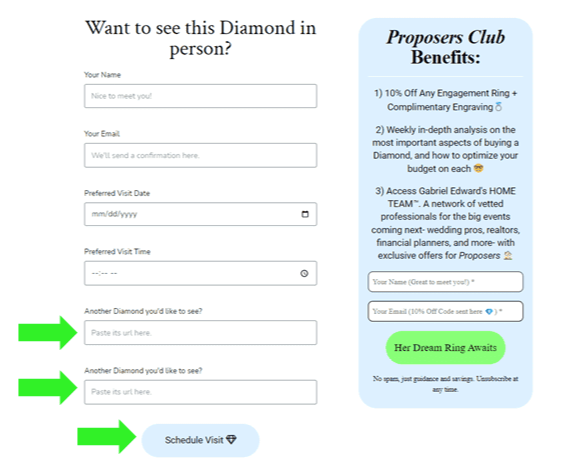
Why make the final selection in person? Here’s 5 reasons we recommend against buying “blind”:

#1. To Evaluate Cut Grade and Proportions
We’ll review each of your finalists under ASET, Ideal, and H&A Scopes. These give you a firsthand look at how well your Diamond reflects light, how symmetrical and evenly-spaced its facets are, and its degree of contrast brilliance. You’ll be able to compare “Excellent” and “Ideal” Cut Diamonds to subpar-cut Diamonds to get a true feel for the importance of your Diamond’s anatomy.
#2. To Determine Your Color Sensitivity
What’s the lowest Color Grade you consider “white”? Does that change once a Diamond is set on a Ring? Would you prefer a larger Diamond with a lower Color Grade or a smaller Diamond with a higher Color Grade in the same budget range?
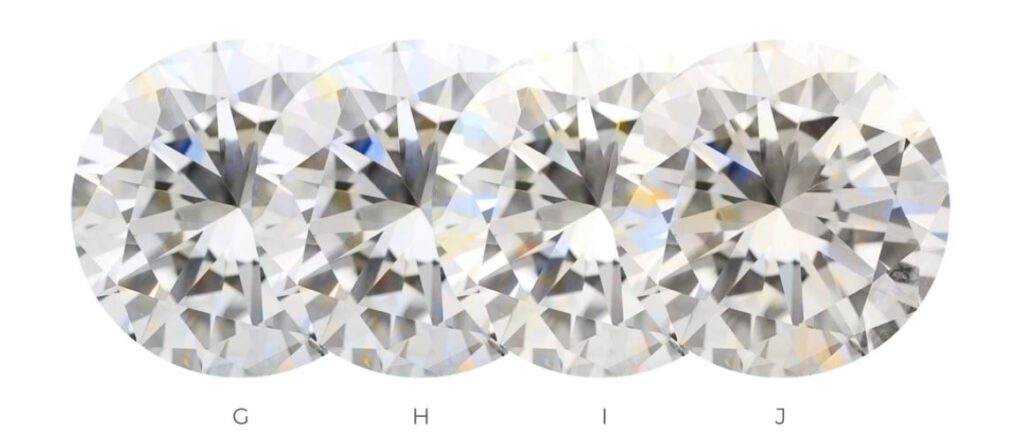

#3. To Evaluate Fluorescent Diamonds Under Different Lights
If any of your finalists contain Fluorescence, we’ll evaluate them under natural, artificial, and concentrated UV light, to make sure that the effects under UV light don’t bother you and also to assure that Fluorescence has only a positive effect on your Diamond.
#4. To See What We Mean By “Eye-clean”
We’ll evaluate different Clarity Grades under both naked-eye and magnified views. Under the lens, we’ll identify each clarity imperfection, and make sure there’s nothing bothersome and nothing you can see with your own eyes.
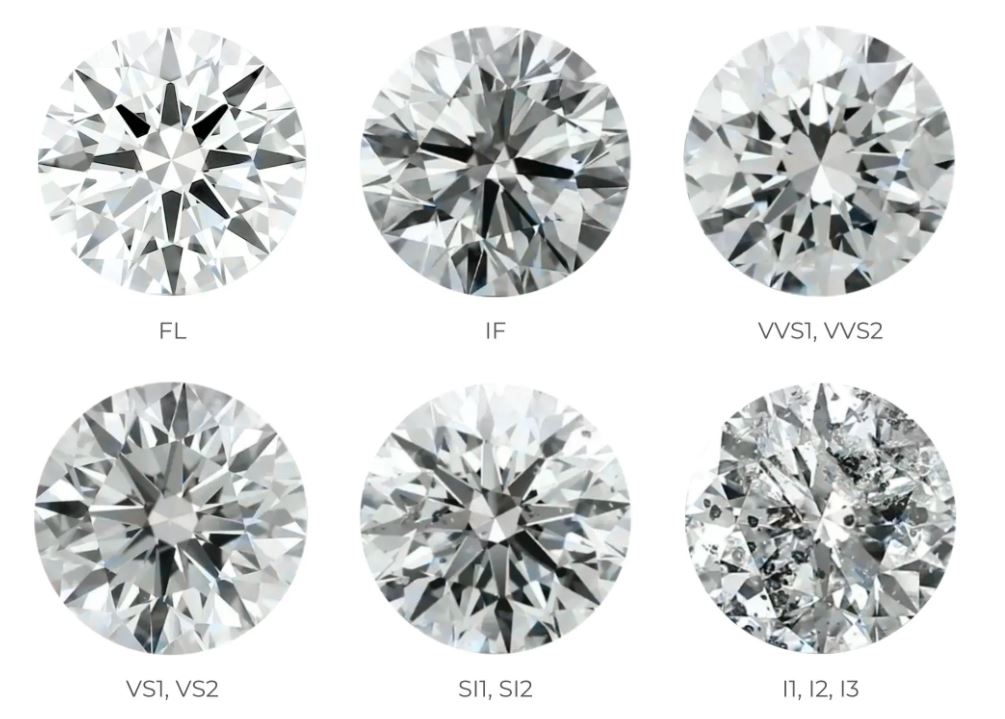
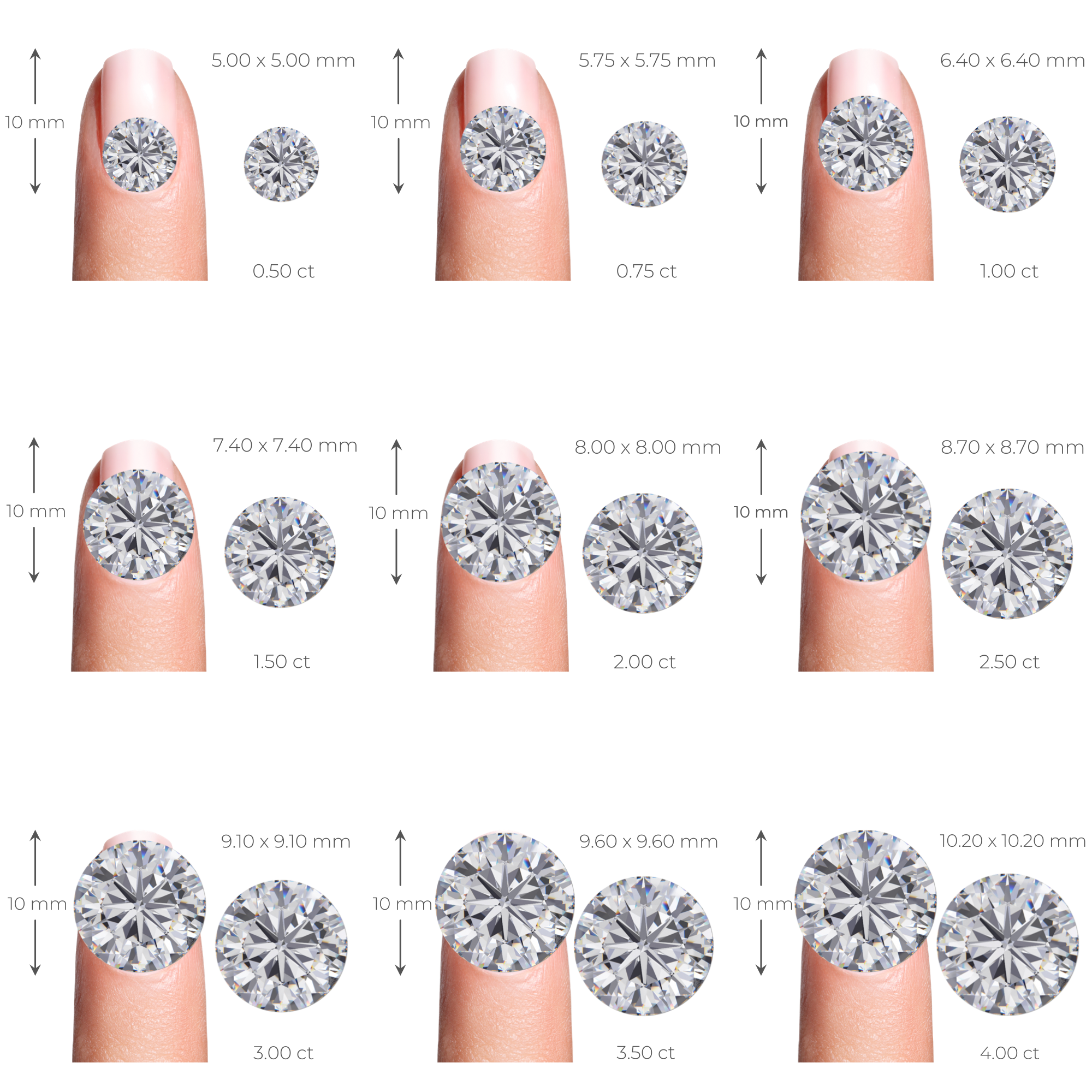
#5. To Get A True Feel For Carat Weight
We want you to get a true feel for the size of your Diamond. Are you comparing a 0.90 carat versus a 1.00 carat? Is a 1.50 carat as big as you thought it’d be? How about when mounted on a Ring? We want you to feel absolutely confident you’re picking the right-sized Diamond.
[mailpoet_form id=”18″]

Javi Perez, Vice President
Our mission is to craft you the Perfect Engagement Ring at an unbeatable price , so you can keep building life with your soulmate.
Reach out to me for help picking the perfect Center Diamond.
- Call me at 888-596-6380 (I’m extension 2)
- Hit the DMs @gabrieledwardjewelers
- Email me at javi@gabrieledwardjewelers.com
- Comment on this post
Thanks for making us a part of your Engagement journey!
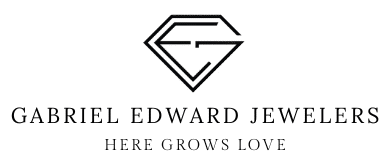
Great blog you have here.. It’s difficult to find
high quality writing like yours nowadays. I really
appreciate people like you! Takke care!!
Review my web blog: https://Www.waste-ndc.pro/community/profile/tressa79906983/
Thank you very much!
To the gabrieledward.com admin, You always provide practical solutions and recommendations.
Thank you, Jacob!